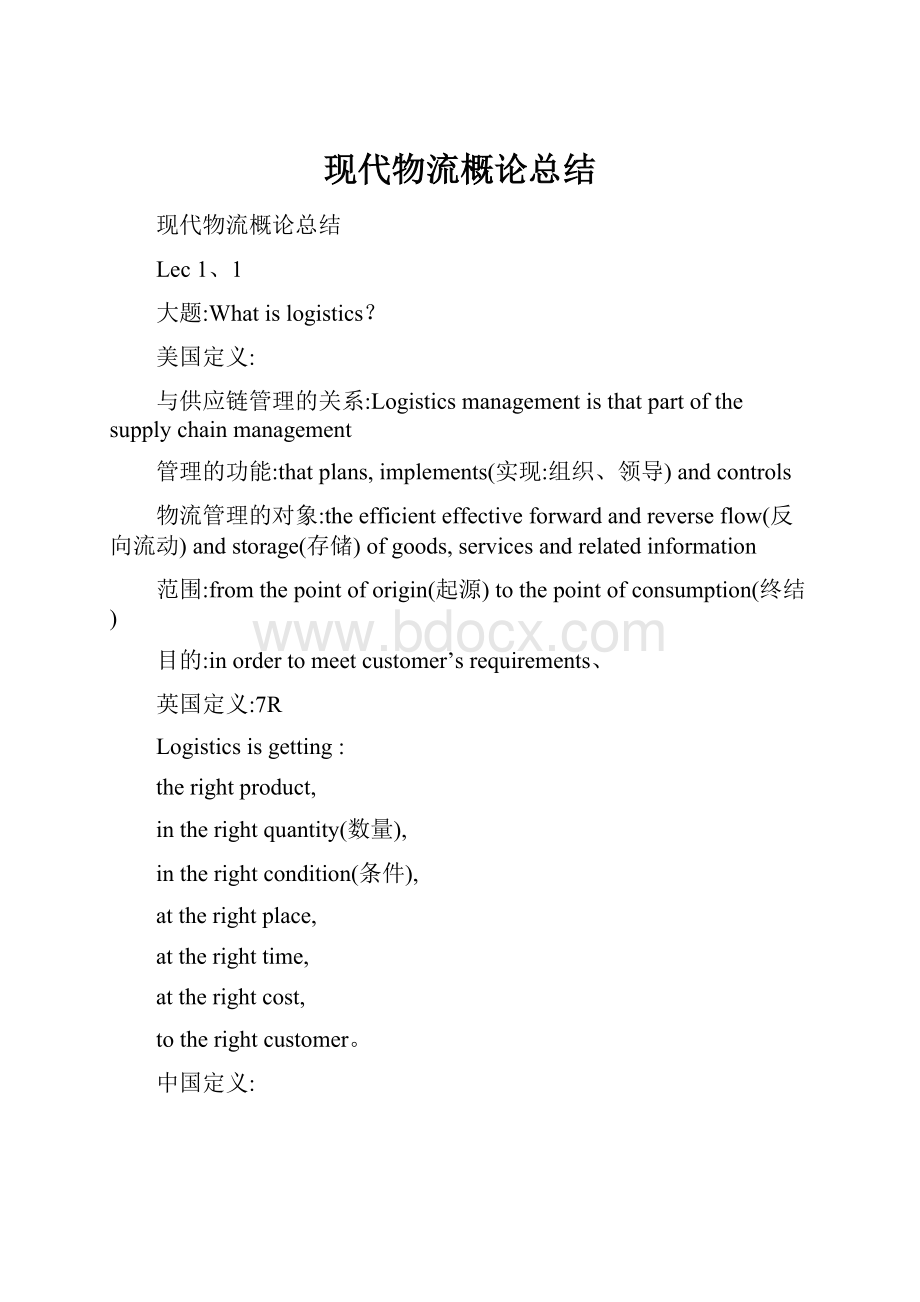现代物流概论总结.docx
《现代物流概论总结.docx》由会员分享,可在线阅读,更多相关《现代物流概论总结.docx(37页珍藏版)》请在冰豆网上搜索。

现代物流概论总结
现代物流概论总结
Lec1、1
大题:
Whatislogistics?
美国定义:
与供应链管理的关系:
Logisticsmanagementisthatpartofthesupplychainmanagement
管理的功能:
thatplans,implements(实现:
组织、领导)andcontrols
物流管理的对象:
theefficienteffectiveforwardandreverseflow(反向流动)andstorage(存储)ofgoods,servicesandrelatedinformation
范围:
fromthepointoforigin(起源)tothepointofconsumption(终结)
目的:
inordertomeetcustomer’srequirements、
英国定义:
7R
Logisticsisgetting:
therightproduct,
intherightquantity(数量),
intherightcondition(条件),
attherightplace,
attherighttime,
attherightcost,
totherightcustomer。
中国定义:
物流(logistics):
物品从供给地向接收地的实体流动过程。
根据实际需要,将运输、储存、装卸、搬运、包装、流通加工、配送、信息处理等基本功能实施有机结合。
物流管理(logisticsmanagement):
以最低的物流成本达到用户所满意的服务水平,对物流活动进行的计划、组织、协调与控制。
大题:
Keycomponents(构成)oflogistics
Transport(运输):
运输就是指用设备与工具,将物品从一地点向另一地点运送的物流活动。
其中包括集货、分配、搬运、中转、装入、卸下、分散等一系列操作。
举例:
运输模式、船队管理、交付操作的类型、装载计划、路线安排。
Storage/warehousing(存储/仓储):
保护、管理、贮藏物品。
举例:
仓储地点、配送仓库的数量与大小、操作类型。
Materialhandling(物料搬运):
在一个存储区域范围内的货物的短距离移动。
举例:
物料搬运的选择、自己完成与外包间的选择。
Inventory(库存):
一个企业所持有的货物的单位量与/或价值。
举例:
存储什么、在哪存储、订购多少、何时订购。
Packaging(包装):
包装就是指为在流通过程中保护商品、方便运输、促进销售,按照一定技术方法而采用容器、材料及辅助物等的总体名称,也指为了达到上述目的的操作活动。
Informationandcontrol(信息与控制):
举例:
订单处理系统、设计系统、采购控制、预测。
Lec1、2
小题:
Whenwasphysicaldistributionsubstitutedbylogisticsformallyinthewesternworld?
(在西方世界传统物流正式被现代物流所取代就是什么时候?
)In1980s、
小题:
WhenwaslogisticsintroducedinJapan?
二战后50s。
小题:
WhenwaslogisticsintroducedinChina?
90s、
小题:
Logisticsandphysicaldistribution?
(现代物流与传统的关系就是什么样的?
)现代物流包含传统物流。
Lec1、3
小题:
Logisticsisthelinksamongdifferententerprisesandindustriesintheeconomysystem、(物流就是经济系统中联系企业与制造业的存在)
Logisticscostisonesignificantelementofsocialtotalcost、(物流成本就是社会总成本中一个重要的元素)
LogisticscostasapercentageofGDPtomeasuretherateofeconomygrowth、(物流成本在GDP中的占比可以衡量经济增长)
大题:
Value-AddedRoleofLogistics(物流的增值角色)
Formutility(what)形式效用:
Referstothevalueaddedtogoodsthrough(指的就是商品价值的增加)、举例:
manufacturing/productionorassembleprocess(制造业产品的组装过程)
Placeutility(where)空间效用:
Avaluethatlogisticscreatesinaproductbychangingtheproduct'slocation(物品地点的转移创造价值)、举例:
Transportationcreatesplaceutility、
Timeutility(when)时间效用:
Avaluecreatedinaproductbyhavingtheproductavailableatthetimedesired(保证产品能够可靠的在一定时间内到达而产生价值)、举例:
Thetransportationandwarehousingcreatetimeutility、
Quantityutility(howmuch)数量效用:
Referstodeliveringtheproperquantitiesofanitemtowhereitisdemanded(指将适当数量的物品运送到需要的地方)、举例:
Logisticscreatesquantityutilitythroughproductionforecasting,productionschedulingandinventorycontrol、(物流通过产品预期,产品计划与库存控制的方式创造数量效用)
Possessionutility(why)占有效用:
举例:
Thevaluecreatedbymarketing’sefforttoincreasethedesiretopossessesagoodorbenefitfromaservice、(这种价值通过营销来增加对物品所有权与益处的服务而创造)
小题:
Effectivelogisticsmanagementcanhelpbusinessreducecostsothatitcanprovidecostadvantage、(成本优势)
Effectivelogisticsmanagementcanhelpprovidesuperiorcustomerservicesothatthiscanenhancedifferentiationadvantage(差异性优势)
大题:
Logisticsinterfacesinthefirm(与企业其她部门的联系):
Manufacturing,Marketing,Accounting、
LogisticsInterfaceswithOperations/Manufacturing:
Lengthofproductionruns(生产运行时间的长短):
Inventorycost(库存成本)
Seasonaldemand(季节需求):
Acceptanceofseasonalinventorytobalanceproductiontimes、(寻求季节性库存与产品供应的平衡)
Supply-sideinterfaces:
Stockingadequatesuppliestoensureuninterruptedproduction、(储备充足的物资,保证不间断生产)
LogisticsInterfaceswithMarketing:
TheMarketingMix–4Ps
Price、Product、Promotion(促销)、Place(渠道)
LogisticsInterfaceswithaccounting:
ROA=grossprofit/asset
Lec1、4
大题:
Whatarecompany’scompetitiveadvantages?
Superiorproductquality(优良的产品质量)
Superiorcustomerservice(优良的客户服务)
Widedistributionnetwork(广泛的配送网络)
Brandloyalty(品牌忠诚)
Patents(专利)
Superiormanagementteamwork(优良的管理团队)
Lowcostplants(低成本工厂)
Ownershipofrawmaterialsupplies(原材料供应所有权)
大题:
CompetitiveAdvantage--Costadvantage
Absolutecostadvantage(Lowercoststhancompetitionatalllevels):
(直接成本优势)
Superiorproductiontechnology(高级生产技术)、
Lowcostinputsupply(低成本投入供给)、
Lowcostoperations(低成本运作)、
Lowerend-to-enddeliveredcostprovidedbylogisticsmanagement(物流管理所提供的更低的终端到终端的交付费用)
Relativecostadvantage:
(间接成本优势)
Economicscale(经济规模)、Experiencecurve(经验曲线)
能够带来的效果:
Capacityutilization(能力利用率)、Scheduleintegration(计划整合)、Lowwaste(低浪费)、Lowinventory(低库存)
大题:
CompetitiveAdvantage--Differentiation
Product:
Quality(质量)、Price、Performance(展示)、Design
Service:
Availability(可用性)、Pre-saleadvice(售前咨询)、Finance(资金供给)、Delivery(配送)、Maintenance(维修)、After-salesservice(售后服务)
MarketingIntangibles:
(营销型无形资产)
Brandidentity(品牌识别)、Brandimage(品牌形象)、Reputation(信誉)、Corporateimage(企业形象)
能够带来的效果:
Tailoredservice(订制服务)、Reliability(可靠性)、Information(信息)、Flexibility(灵活性)、Responsiveness(反应性)
Lec1、5
小题:
Whatisasystem?
系统就是由一组相互关联,功能相关的要素、变量、部件,物体组成的统一整体、
小题:
WhatisSystemsConcept?
系统概念就是强调整体有效性而非强调系统的个体的有效性的一种决策方法、
小题:
ElementsofLogisticsSystem:
流动要素7要素:
流体、载体、流向、流量、流程、流速、流效
小题:
CostPerspective
Themostefficientsystemsarenotalwayscomprisedofeachsystemcomponentoperatingatitslowestpossiblecost、(最有效的系统不总就是每个子系统操作成本最低的系统)
Thecriticalconcernistohavetheentiresystemoperatingatitslowesttotalcost、(关键就是要让着整个系统以最低的成本运作)
大题:
WhatisOptimization?
(优化)
Theprocessofmakingsomethingasgoodoraseffectiveaspossiblewithgivenresourcesandconstraints(限制)、(在给定资源与约束条件下,使某物尽可能好的方法或尽可能有效的方法)
举例:
deliverytimes(交货时间),minimumproductioncapacity(最小生产能力),financiallimits(金融限制)
LevelofOptimality:
Withinlogisticscomponents(物流组件内部)
Betweenlogisticscomponents(物流组件之间)
Betweencompanyfunctions(公司行为之间)
Betweenthecompanyandexternalorganization(公司与外部组织之间)
大题:
ApproachestoAnalyzingLogisticsSystems
MaterialsManagementv、PhysicalDistribution:
材料管理与传统物流
Materialmanagement(inboundlogistics)输入物流:
Themovementandstorageofmaterialsfromsuppliersandvendorsintoproductionprocesses、(物料从供应商到生产过程的运动与储存)
Physicaldistribution(outboundlogistics)输出物流:
Theprocessrelatedtothemovementandstorageofproductsfromtheendoftheproductionlinetotheenduser、(从生产线到终端用户的移动与存储产品的过程。
)
4differentclassificationsoflogisticssystems:
Balancedsystem(平衡系统)-e、g、,consumerproducts(消费品)
Heavyinbound(偏进货型)-e、g、,aircraft,construction(造船、建筑业)
Heavyoutbound(偏出货型)-e、g、,chemicals(化学品)
Reversesystems(逆向系统)-e、g、,returnableproducts(可回收物品)
CostCenters:
成本中心
TotalLogisticscost(物流总成本):
Trunkingcost(primarydelivery,初级配送)点对点:
工厂——配送中心
Localdeliverycosts(secondarydelivery,二级配送)点对多点:
配送中心——很多客户
Orderprocessingcosts(informationsystemcost)(订单处理成本)
Inventoryholdingcosts(库存持有成本)
Warehousing/storagecosts(仓储成本)
Costtrade-off(成本悖反原理):
Theinterrelationshipamongsystemvariablesindicatesthatachangeinonevariablehascostimpactuponothervariables、(系统变量之间的相互关系表明,一个变量变化也会影响其她变量变化)
增加仓库的数量:
不利于风险分担、汇集预测,因此满足客户需求需要远多于原先的库存成本。
NodesversusLinks:
节点与连线
Nodesarespatialpoints:
节点就是空间上的点
举例:
仓库、工厂。
Linksarethetransportationnetwork:
连线构成运输网络
举例:
铁路、摩托、空运、管道、水运。
LogisticsChannel:
物流渠道
Thenetworkofintermediaries(n、中介,中间商)involvedin(参与)thelogisticssystem、
inwhichparticipants(参与)engagedin(从事)storage,handling,transfer,transportation,andcommunicationsfunctionsthatcontributeto(有助于)theefficientflow(流动)ofgoods、
Lec2
大题:
DriversofTheBusinesschange
TheEmpoweredConsumer(日益强大的消费者):
Informedconsumers(Multiplechannelsofinformation)(通知消费者)
Time--keyconsiderationfactor(时间——关键考虑要素)
Higherqualityrequirement(高质量需求)
Lessloyalty(更低的忠诚度)
PowershiftinthesupplychainandOrganizationconsolidation:
(供应链中权力转移与组织的融合):
Largeretailersmoredemandingandcommanding(大量零售商的需求)
Lowcoststrategy“everydaylowprices”、(低成本战略“天天低价”)
举例:
Wal-Mart,ToyRus,HomeDepot
Largeretailers’pressureontheirsupplier(manufacturer)tofocusonlogisticsandsupplychainstrategy(大量的零售商给了供应商在注重物流与供应链战略上的压力)
企业之间合作越来越多,如VMI(供应商管理库存)
Governmentpolicyandregulation(政府的政策与规制):
解除管制,增加竞争
举例:
Telecommunication(电信)、Transportation(运输)、Finance(金融)、Energy(能源)
Globalization(全球化):
最主要的驱动力
Globalmarketplace(市场),Globalsourcing(采购),manufacturing(制造),marketing(营销)anddistribution(分配),etc、、
Supplychainmanagement=globalsupplychainmanagement
Technology(技术):
Changedriveraswellasafacilitatorofchange(变革的工具);
Informationprovidesnewandunrestricted(不受限)accesstotheplaceaspectofbusiness、
举例:
互联网
Warehousetechnology(仓储技术)
Dataprocessinganddataanalysis(数据进程与数据分析)
Communication(沟通)
SustainableDevelopment(可持续发展):
臭氧层、热带雨林、全球变暖、酸雨、核废料、能源储备、可耕地减少、噪音污染环境等保护问题
EnvironmentalProtectionFactor(环境保护因素)
GreenLogisticsystem(绿色物流系统)
Packagingandtransportation(包装与运输)
大题:
WhatisASupplyChain?
就是什么:
Asupplychaincanbeviewedasaseriesofintegratedenterprises(oranextendedenterprise拓展的企业)
做什么:
thatshareinformationandcoordinate(协调)physicalexecution(执行)
内容:
toensureasmooth,integrated(完整的)flowofgoods,service,informationandcashthroughthepipeline(渠道)、
大题:
WhatIsSupplyChainmanagement?
整体指的就是:
SupplychainmanagementistheINTEGRATION(整体)ofthoseupstream(上游)anddownstream(下游)flowsofproducts,services,informationandcash。
参与者:
acrossboundariesofsuppliers,manufacturers,wholesalers(批发商)andretailers(零售商)andendcustomersinasupplychain。
目标:
minimizetotalsystemcost(最小化整体系统成本)andsatisfycustomerservicerequirements(满足客户需求)
国际定义:
Themanagementofupstream(inbound)anddownstream(outbound)relationshipwithsuppliersandcustomerstodeliversuperiorcustomervalueatlesscosttothesupplychainasawhole、(上游输入物流与下游输出物流的关系与顾客与配送顾客低成本供应链的整体)
中国定义:
利用计算机网络技术全面规划供应链中的商流、物流、信息流、资金流等并进行计划、组织、协调与控制。
大题:
RelationshipbetweenLMandSCM
Supplychainmanagementisverymuchastrategicplanningprocess,withaparticularemphasisonstrate